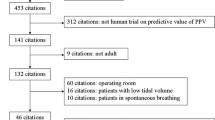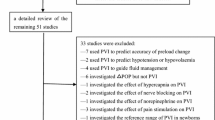Abstract
Purpose
To systematically review the accuracy of the variation in pulse oxymetry plethysmographic waveform amplitude (∆POP) and the Pleth Variability Index (PVI) as predictors of fluid responsiveness in mechanically ventilated adults.
Methods
MEDLINE, Scopus and the Cochrane Database of Systematic Reviews were screened for clinical studies in which the accuracy of ∆POP/PVI in predicting the hemodynamic response to a subsequent fluid bolus had been investigated. Random-effects meta-analysis was used to summarize the results. Data were stratified according to the amount of fluid bolus (large vs. small) and to the study index (∆POP vs. PVI).
Results
Ten studies in 233 patients were included in this meta-analysis. All patients were in normal sinus rhythm. The pooled area under the receiver operating characteristic curve (AUC) for identification of fluid responders was 0.85 [95 % confidence interval (CI) 0.79–0.92]. Pooled sensitivity and specificity were 0.80 (95 % CI 0.74–0.85) and 0.76 (0.68–0.82), respectively. No heterogeneity was found within studies with the same amount of fluid bolus, nor between studies on ∆POP and those on PVI. The AUC was significantly larger in studies with a large bolus amount than in those with a small bolus [0.92 (95 % CI 0.87–0.96) vs. 0.70 (0.62–0.79); p < 0.0001]. Sensitivity and specificity were also higher in studies with a large bolus [0.84 (95 % CI 0.77–0.90) vs. 0.72 (0.60–0.82) (small bolus), p = 0.08 and 0.86 (95 % CI 0.75–0.93) vs. 0.68 (0.56–0.77) (small bolus), p = 0.02], respectively.
Conclusions
Based on our meta-analysis, we conclude that ∆POP and PVI are equally effective for predicting fluid responsiveness in ventilated adult patients in sinus rhythm. Prediction is more accurate when a large fluid bolus is administered.

Similar content being viewed by others
References
Cavallaro F, Sandroni C, Antonelli M (2008) Functional hemodynamic monitoring and dynamic indices of fluid responsiveness. Minerva Anestesiol 74:123–135
Marik PE, Cavallazzi R, Vasu T, Hirani A (2009) Dynamic changes in arterial waveform derived variables and fluid responsiveness in mechanically ventilated patients: a systematic review of the literature. Crit Care Med 37:2642–2647
Marik PE, Baram M, Vahid B (2008) Does central venous pressure predict fluid responsiveness? A systematic review of the literature and the tale of seven mares. Chest 134:172–178
Michard F, Boussat S, Chemla D, Anguel N, Mercat A, Lecarpentier Y, Richard C, Pinsky MR, Teboul JL (2000) Relation between respiratory changes in arterial pulse pressure and fluid responsiveness in septic patients with acute circulatory failure. Am J Respir Crit Care Med 162:134–138
Tavernier B, Makhotine O, Lebuffe G, Dupont J, Scherpereel P (1998) Systolic pressure variation as a guide to fluid therapy in patients with sepsis-induced hypotension. Anesthesiology 89:1313–1321
Berkenstadt H, Margalit N, Hadani M, Friedman Z, Segal E, Villa Y, Perel A (2001) Stroke volume variation as a predictor of fluid responsiveness in patients undergoing brain surgery. Anesth Analg 92:984–989
Shamir M, Eidelman LA, Floman Y, Kaplan L, Pizov R (1999) Pulse oximetry plethysmographic waveform during changes in blood volume. Br J Anaesth 82:178–181
Shelley KH (2007) Photoplethysmography: beyond the calculation of arterial oxygen saturation and heart rate. Anesth Analg 105:S31–S36, tables of contents
Moher D, Liberati A, Tetzlaff J, Altman DG (2009) Preferred reporting items for systematic reviews and meta-analyses: the PRISMA statement. J Clin Epidemiol 62:1006–1012
Desebbe O, Cannesson M (2008) Using ventilation-induced plethysmographic variations to optimize patient fluid status. Curr Opin Anaesthesiol 21:772–778
Cannesson M, Desebbe O, Rosamel P, Delannoy B, Robin J, Bastien O, Lehot JJ (2008) Pleth variability index to monitor the respiratory variations in the pulse oximeter plethysmographic waveform amplitude and predict fluid responsiveness in the operating theatre. Br J Anaesth 101:200–206
Zimmermann M, Feibicke T, Keyl C, Prasser C, Moritz S, Graf BM, Wiesenack C (2010) Accuracy of stroke volume variation compared with pleth variability index to predict fluid responsiveness in mechanically ventilated patients undergoing major surgery. Eur J Anaesthesiol 27:555–561
Cannesson M, Delannoy B, Morand A, Rosamel P, Attof Y, Bastien O, Lehot JJ (2008) Does the Pleth variability index indicate the respiratory-induced variation in the plethysmogram and arterial pressure waveforms? Anesth Analg 106:1189–1194, table of contents
Whiting P, Rutjes AW, Reitsma JB, Bossuyt PM, Kleijnen J (2003) The development of QUADAS: a tool for the quality assessment of studies of diagnostic accuracy included in systematic reviews. BMC Med Res Methodol 3:25
Zamora J, Abraira V, Muriel A, Khan K, Coomarasamy A (2006) Meta-DiSc: a software for meta-analysis of test accuracy data. BMC Med Res Methodol 6:31
Altman DG, Bland JM (2003) Interaction revisited: the difference between two estimates. Br Med J 326:219
Cannesson M, Attof Y, Rosamel P, Desebbe O, Joseph P, Metton O, Bastien O, Lehot JJ (2007) Respiratory variations in pulse oximetry plethysmographic waveform amplitude to predict fluid responsiveness in the operating room. Anesthesiology 106:1105–1111
Desgranges FP, Desebbe O, Ghazouani A, Gilbert K, Keller G, Chiari P, Robin J, Bastien O, Lehot JJ, Cannesson M (2011) Influence of the site of measurement on the ability of plethysmographic variability index to predict fluid responsiveness. Br J Anaesth 107:329–335
Feissel M, Teboul JL, Merlani P, Badie J, Faller JP, Bendjelid K (2007) Plethysmographic dynamic indices predict fluid responsiveness in septic ventilated patients. Intensive Care Med 33:993–999
Hoiseth LO, Hoff IE, Skare O, Kirkeboen KA, Landsverk SA (2011) Photoplethysmographic and pulse pressure variations during abdominal surgery. Acta Anaesthesiol Scand 55:1221–1230
Hood JA, Wilson RJ (2011) Pleth variability index to predict fluid responsiveness in colorectal surgery. Anesth Analg 113:1058–1063
Natalini G, Rosano A, Taranto M, Faggian B, Vittorielli E, Bernardini A (2006) Arterial versus plethysmographic dynamic indices to test responsiveness for testing fluid administration in hypotensive patients: a clinical trial. Anesth Analg 103:1478–1484
Solus-Biguenet H, Fleyfel M, Tavernier B, Kipnis E, Onimus J, Robin E, Lebuffe G, Decoene C, Pruvot FR, Vallet B (2006) Non-invasive prediction of fluid responsiveness during major hepatic surgery. Br J Anaesth 97:808–816
Wyffels PA, Durnez PJ, Helderweirt J, Stockman WM, De Kegel D (2007) Ventilation-induced plethysmographic variations predict fluid responsiveness in ventilated postoperative cardiac surgery patients. Anesth Analg 105:448–452
La Torre G, Chiaradia G, Gianfagna F (2006) Quality assessment in meta-analysis. Ital J Public Health 3:69–76
Awad AA, Stout RG, Ghobashy MA, Rezkanna HA, Silverman DG, Shelley KH (2006) Analysis of the ear pulse oximeter waveform. J Clin Monit Comput 20:175–184
Dorlas JC, Nijboer JA (1985) Photo-electric plethysmography as a monitoring device in anaesthesia: application and interpretation. Br J Anaesth 57:524–530
Monnet X, Lamia B, Teboul JL (2005) Pulse oximeter as a sensor of fluid responsiveness: do we have our finger on the best solution? Crit Care 9:429–430
Cannesson M, Besnard C, Durand PG, Bohe J, Jacques D (2005) Relation between respiratory variations in pulse oximetry plethysmographic waveform amplitude and arterial pulse pressure in ventilated patients. Crit Care 9:R562–R568
Partridge BL (1987) Use of pulse oximetry as a noninvasive indicator of intravascular volume status. J Clin Monit 3:263–268
Heenen S, De Backer D, Vincent JL (2006) How can the response to volume expansion in patients with spontaneous respiratory movements be predicted? Crit Care 10:R102
Delerme S, Castro S, Freund Y, Nazeyrollas P, Josse MO, Madonna-Py B, Rouff E, Riou B, Ray P (2010) Relation between pulse oximetry plethysmographic waveform amplitude induced by passive leg raising and cardiac index in spontaneously breathing subjects. Am J Emerg Med 28:505–510
Keller G, Cassar E, Desebbe O, Lehot JJ, Cannesson M (2008) Ability of pleth variability index to detect hemodynamic changes induced by passive leg raising in spontaneously breathing volunteers. Crit Care 12:R37
Cavallaro F, Sandroni C, Marano C, La Torre G, Mannocci A, De Waure C, Bello G, Maviglia R, Antonelli M (2010) Diagnostic accuracy of passive leg raising for prediction of fluid responsiveness in adults: systematic review and meta-analysis of clinical studies. Intensive Care Med 36:1475–1483
Broch O, Bein B, Gruenewald M, Hocker J, Schottler J, Meybohm P, Steinfath M, Renner J (2011) Accuracy of the pleth variability index to predict fluid responsiveness depends on the perfusion index. Acta Anaesthesiol Scand 55:686–693
Yamaura K, Irita K, Kandabashi T, Tohyama K, Takahashi S (2007) Evaluation of finger and forehead pulse oximeters during mild hypothermic cardiopulmonary bypass. J Clin Monit Comput 21:249–252
Antonelli M, Levy M, Andrews PJ, Chastre J, Hudson LD, Manthous C, Meduri GU, Moreno RP, Putensen C, Stewart T, Torres A (2007) Hemodynamic monitoring in shock and implications for management. International Consensus Conference, Paris, France, 27–28 April 2006. Intensive Care Med 33:575–590
Biais M, Cottenceau V, Petit L, Masson F, Cochard JF, Sztark F (2011) Impact of norepinephrine on the relationship between pleth variability index and pulse pressure variations in ICU adult patients. Crit Care 15:R168
Landsverk SA, Hoiseth LO, Kvandal P, Hisdal J, Skare O, Kirkeboen KA (2008) Poor agreement between respiratory variations in pulse oximetry photoplethysmographic waveform amplitude and pulse pressure in intensive care unit patients. Anesthesiology 109:849–855
Cannesson M, Awad AA, Shelley K (2009) Oscillations in the plethysmographic waveform amplitude: phenomenon hides behind artifacts. Anesthesiology 111:206–207, author reply 207–208
Shelley KH, Awad AA, Stout RG, Silverman DG (2006) The use of joint time frequency analysis to quantify the effect of ventilation on the pulse oximeter waveform. J Clin Monit Comput 20:81–87
Awad AA, Ghobashy MA, Ouda W, Stout RG, Silverman DG, Shelley KH (2001) Different responses of ear and finger pulse oximeter wave form to cold pressor test. Anesth Analg 92:1483–1486
Bendjelid K (2008) The pulse oximetry plethysmographic curve revisited. Curr Opin Crit Care 14:348–353
De Backer D, Heenen S, Piagnerelli M, Koch M, Vincent JL (2005) Pulse pressure variations to predict fluid responsiveness: influence of tidal volume. Intensive Care Med 31:517–523
Acknowledgments
We gratefully thank Dr. Giuseppe Natalini, MD (Chief of Intensive Care Unit, Fondazione Poliambulanza–Istituto Ospedaliero, Via Bissolati 57, 25124 Brescia, Italy) for having provided the raw data from his study for our meta-analysis.
Conflicts of interest
None.
Author information
Authors and Affiliations
Corresponding author
Electronic supplementary material
Below is the link to the electronic supplementary material.
Rights and permissions
About this article
Cite this article
Sandroni, C., Cavallaro, F., Marano, C. et al. Accuracy of plethysmographic indices as predictors of fluid responsiveness in mechanically ventilated adults: a systematic review and meta-analysis. Intensive Care Med 38, 1429–1437 (2012). https://doi.org/10.1007/s00134-012-2621-1
Received:
Accepted:
Published:
Issue Date:
DOI: https://doi.org/10.1007/s00134-012-2621-1




